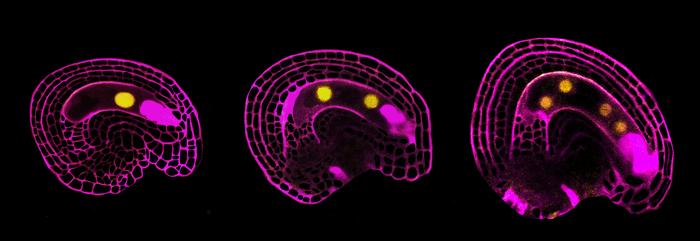Seeds are the end product of plant reproduction. Whether directly as food, or indirectly as animal feed, they provide around 80 percent of human calorie consumption. In the millennia since humans first settled, we have bred countless plant varieties with advantageous characteristics, such as increased yields, improved quality, resistance to pests or hardiness. Where possible, farmers use hybrid varieties, which are created by crossing two inbred lines and are more resistant and higher-yielding than normal varieties. The problem is that these desired properties are lost during propagation and, therefore, hybrid seeds have to be recreated every year.

Credit: Sara Simonini, University of Zurich
Seeds are the end product of plant reproduction. Whether directly as food, or indirectly as animal feed, they provide around 80 percent of human calorie consumption. In the millennia since humans first settled, we have bred countless plant varieties with advantageous characteristics, such as increased yields, improved quality, resistance to pests or hardiness. Where possible, farmers use hybrid varieties, which are created by crossing two inbred lines and are more resistant and higher-yielding than normal varieties. The problem is that these desired properties are lost during propagation and, therefore, hybrid seeds have to be recreated every year.
Sperm-derived signal activates cell division of the female gamete
If we could find a way to propagate crop plants by asexual reproduction through seeds – known as apomixis – it would revolutionize agriculture. If it were possible to bypass the reductional division and fertilization of female gametes, the seeds produced would be genetically identical to the mother plant. Plant varieties with desired characteristics could thus be propagated much more easily – as seed clones. Now, Ueli Grossniklaus and his team at the Department of Plant and Microbial Biology at the University of Zurich (UZH) have come a step closer to achieving this goal. “In the model plant thale cress, we have discovered the signal that activates the female gamete to form a new seed,” says Grossniklaus.
The fertilization process in plants consists of two events. Two sperm cells merge with one female gamete each – one sperm cell fertilizes the egg, from which the embryo and ultimately the next generation is formed, while the other one fuses with the central cell, which develops into a placenta-like tissue that supplies the embryo with nutrients. Together, they develop into mature seeds. For fertilization to be successful, sperm cells and female gametes must be in the same phase of the cell cycle – in other words, they need to be “in sync” with each other.
Synchronization precedes gamete division
Scientists already knew that the sperm cells in thale cress (Arabidopsis thaliana) are in the preparatory phase for cell division. Grossniklaus’ team has now shown that the quiescent egg cell is also in this phase. The central cell, on the other hand, remains stuck in the middle of the preceding phase, in which the genetic material gets duplicated. While sperm and egg cells are in the same cell cycle phase, the central cell must first complete DNA synthesis after fertilization before the first division can begin.
This interruption in the cell cycle is caused by a protein in the central cell that is not completely degraded and is thus still present. When the sperm fertilizes this gamete, it introduces the protein cyclin, which then activates the decomposition of the inhibitory protein. Only then can the central cell complete DNA synthesis and move into the next phase of the cell cycle. “For the first time, we have managed to figure out the molecular mechanism of how the signal is delivered from the sperm to the female gamete in order to shift it out of its quiescent state. It signals to the central cell that fertilization was successful and that cell division can now take place,” says first author Sara Simonini.
Asexual reproduction for crops
If thale cress were to be genetically modified such that the central cells produced the protein cyclin themselves, they would begin to divide even without fertilization. “We can now deliberately trigger this activation in the absence of fertilization. This opens up opportunities to introduce apomixis in crop plants, in particular in hybrid varieties that are more resilient and produce higher yields than normal varieties,” says Grossniklaus. If apoximis could be harnessed in crop plants, millions of small-scale farmers in the Global South would for the first time be able to grow hybrid varieties whose seeds could be saved for the next sowing.
Journal
Science
DOI
10.1126/science.adj4996
Method of Research
Experimental study
Subject of Research
Not applicable
Article Title
A paternal signal induces endosperm proliferation upon fertilization in Arabidopsis
Article Publication Date
9-Feb-2024




